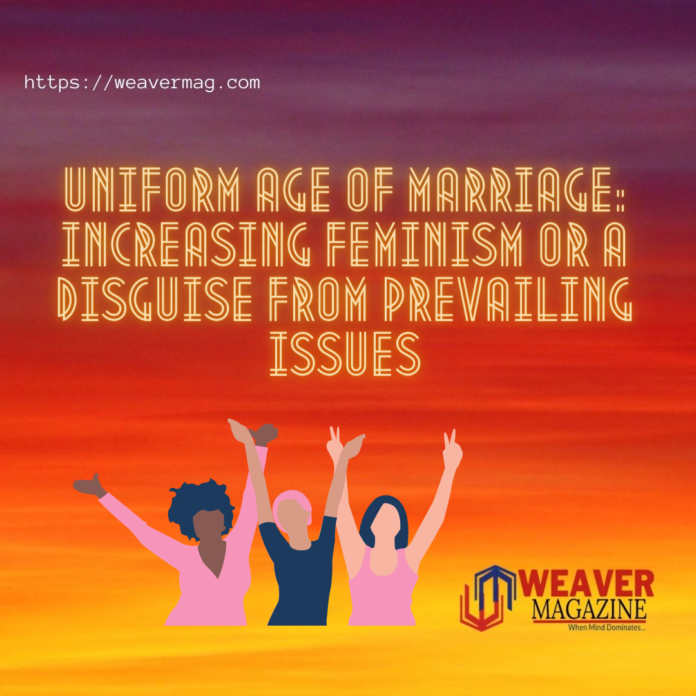Equality is the new norm of this neo-liberal regime, supported by numerous profound personalities. Mentioned norm is inclusive of “uniform age of marriage”, a long contentious matter in Indian socio-legal context. During budget of 2020-21, FinMin Nirmala Sitharaman corroborated above thesis and issued statement regarding revision of legal age of marriage for women from 18 to 21. Subsequently setting up of a task force “age at marriage”. Following move was hailed by many as decisive towards curtailing and curbing the problem of child marriage. Nonetheless, various activists are of the view that it is rhetoric of government, straightforwardly aimed at increasing sentiments of feminism across globe and disguising from issues pertinent to gender inequality.
With Government of India establishing task force the issue of uniform age of marriage has once again came into light of national concern. Legal age of marriage is not a brand new issue and nor a recently developed one. It all started in Dadaji Bhikaji Vs Rukhmabai on 21st September, 1885, when she was married to Dadaji Bhikaji during an age of just 11 years. After turning to 19, she denied to go and live with her husband in quest of her ambitions. Acknowledging the case, Robert Hill Phinney, the then justice found difficult to apply British Law of Consent due to orthodox Indian marriage system. He later on deduced that Rukhmabai was too small during instance of her informal marriage agreement and simultaneously adjudicated herself with her freedom. But contradictorily, it doesn’t went well with Indian conservative society which led to reopening of case. However, Rukhmabai was hard core struggler. She wrote letter to the editor of The Times under guise of “Hindoo Lady” to involve Queen of Britain. Which served as compulsion for Queen Victoria To intervene. As a result Rukhmabai left the ill-fated journey of her life and went to London to learn doctory.
The rhetoric of feminism is global where social activists, NGOs, scholars, researchers, media personnel, philanthropists and pupil are vibrant participants. Similarly our Prime Minister, Narendra Modi, on the eve of 15 August 2020 i.e. Independence Day reiterated his point of revising marital age. But there is no evidence that tinkering with age of marriage will benefit women in any way. Main focus or agenda should be on analysing and comprehensively dealing with the issues relevant to gender inequality. The eloquence sounds well but the government is missing the opportunity to focus on solving the real issues like child marriage. Several underlying and India-specific issues include poverty, betrothal, level of education, traditional customs, gender norms, pre-marital sex and violence against girls.
Evidences of various multilateral forums and survey units suggests that principal issue is child marriage, in which mainly repercussions are survived by girls. According to UNICEF , India has highest absolute number of child brides in the world—15,509,000. Child marriage is greatly influenced by gender inequality as conservatively girls are considered somehow inferior to boys. Poorer girls perceived as economic burden are severely prone to child marriage and often married at young age to reduce dowry. Parents in India are largely dedicative towards securitization of future of their respective daughters hence leading to betrothal i.e. girls are promised in marriage before they are born. The roots of illiteracy is so compact that its extent may seem eternal, as consequence of same, parents having low level of education or no education consider girls as “paraya dhan” i.e. someone else wealth thereby educating daughter is of less priority as compared to boys. A report as a result of NFHS-4 proves that women education level is also found to be negatively associated with prevalence of child marriage for 15-19 age group. In the same age group almost 30.8 % girls don’t have any education. The fact consolidate that reducing and increasing marital age may seem feasible on white paper but actual bottlenecks life somewhere else and no significant testimony is there to conclude uniform age will benefit women especially downtrodden. Although India is acceded to the Convention on the Right of Children, 1992, which ensured minimum age of marriage as 18 and ratified the Convention on the Elimination of All Forms of Discrimination Against Women (CEDAW) in 1993, which confirms state to ensure free and full consent to marriage. Realising child marriage is a rural phenomenon where consent of girls are negligible. Thereupon, more thrust is required on law side to prevent dissent driven marriages.
Child marriage is not only derogatory to the individual country or hazardous to the Global reputation but its adversaries engulf the female counterpart in a brutal manner. Most child marriages result in teenage pregnancies due to social pressure and lack of sexual and reproductive health knowledge. Sample groups between age of 15-19 years almost 31.5% of the sample girls have babies. It is important to point that almost a quarter of married girls in 15-16 years have at least one baby while more than quarter of girls had one child at age of 17. Its highest effect is observed in northeast where percentage of married teenage girls having at least one child is immense; Mizoram(60.8%), Nagaland (52.6%) and Meghalaya (52.9%). In physiological and psychological ambience girls are very weak during teenage exacerbated by early marriage, premature deliveries, less nutritional food, mental stability, financial burden, family circumstances which accordingly needed to be solved on behalf of government.
The current legal framework, Prohibition of Child Marriage Act, 2006 the minimum legal age for marriage in India is 18 years for girls and 21 for boys. But on other hand, regionally diversified India also faces complexities in its interpretation. Many petitioners argue that provisions of act do not apply to Muslims as marriage between Muslim are governed by Muslim Personal Law under the Muslim Person Law (Shariat) Application Act, 1937. This interpretations has been consistently negated by Indian Judiciary. Due to ambiguous laws, these age criterias are not felt as boundation by many ethnic communities witnessing enormous instances of child marriage. And even minimum age of marriage should be distinguished from mandatory age. It only signifies that below prescribed age there could be criminal prosecution but fails in order to halt the same.
Downtrodden girls from Scheduled Tribes (STs), Scheduled Castes (SCs) and Other Backward Classes(OBCs) suffers great devastation. Comparing there all-around destruction with an apocalypse is not wrong. Taking into consideration the stats of NFHS-4, it is visible that prevalence of child marriage is reported greatly among ST girls(15%)and SC girls (13%). Furthermore, Bihar, Gujarat, Arunachal Pradesh, Maharshtra and West Bengal has highest generality among these categories. No remarkable effort is seen from government to redress their grievances. India is currently committed to revising of marital age as promised by Mr Narendra Modi. If somehow legalised, prevalent patriarchy will not acknowledge these provisions leading to fatal condition of women. For women it is always “Or” and never “And” condition and their current disposition is very bad because the mentality of male and orthodox society is based on idea that woman should marry early. We are hypothesized that same marriage age would benefit women and diminish or remove gender inequality. Cage of feminism is so broad and eclectic that no single unit is escapable. The same sentiment of feminism is widely circulated and propagated by electronic medias. Same stance is followed by government of India promoting the already uplifted sentiment of feminism.
On conclusion note, the move to increase legal age of marriage for girls to 21 does not lie solely in vacuum and should be coupled with manoeuvres mitigating socio-economic inequities. Education is the vital key to save our upcoming generation from drastic by products of early marriage, specifically girls. Hence more and more focus should be on inclusive, decentralized and robust mechanism for educating girls and their respective families. Revising of age may trigger immediate sense of gender equality but further more is needed to promote the same.







